Family : Lemuridae

Text © DrSc Giuliano Russini – Biologist Zoologist

English translation by Mario Beltramini
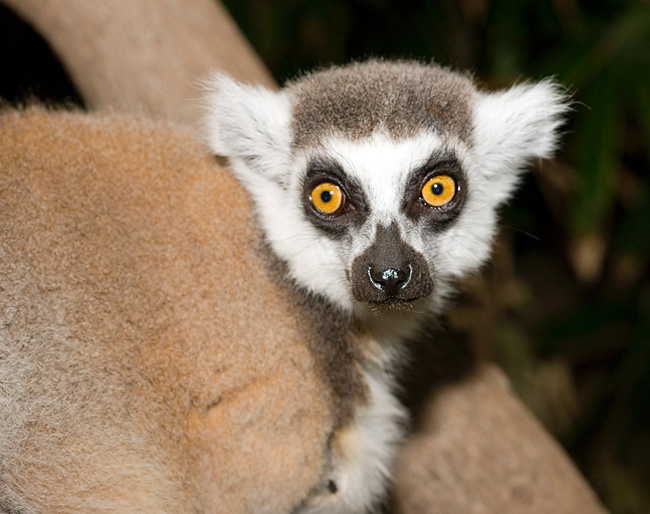
Ovid says that the "night lemures" were the dead souls restlessly wandering during the night © Giuseppe Mazza
A special climate, in addition to such prolonged confinement, has made this island a natural laboratory of the evolution and a paradise for the biologist, as it is the case of the Galapagos, the Acores, the Papua New Guinea, the Amazonia, the Tasmania and Australia.
Here are present, as a matter of fact, animal and vegetal forms elsewhere disappeared, among which stand the mysterious lemurs.
Madagascar Island, with its 58.900 square kilometres of surface is one of the largest islands of the planet, precisely the fourth, after Greenland, New Guinea and Borneo.
It is located in the Indian Ocean, off the south-eastern coast of Africa, from which is separated by the Mozambique Channel.
The mountain systems, the geological constitution and the climate do characterize and define three main regions: the central highlands, the eastern coast mountain range and the vast western and southern plains more or less dotted with hills and mountains.
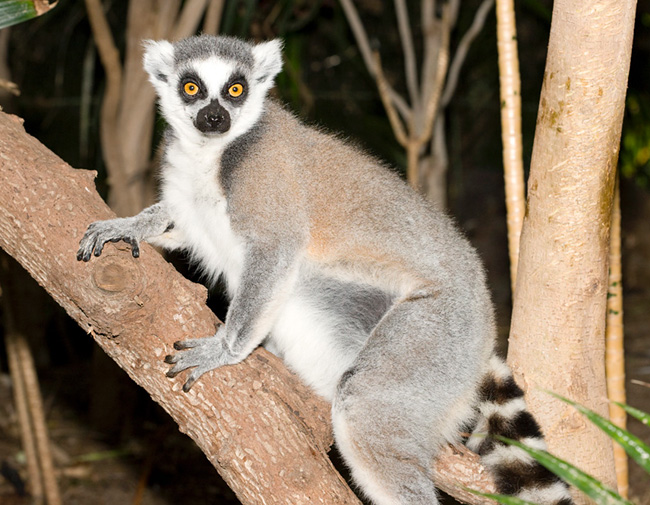
From this, due to the shining eyes and the appalling night screams, comes the name of lemur © Giuseppe Mazza
As stated before, it parted from the continental African shelf more or less ten million of years ago (even if the geo-chronological origin of this event is still uncertain); this has prevented outside invaders to come and disturb the underway natural evolution.
Still nowadays, despite that the 75% of the woodlands have disappeared because of the human beings looking for areas to exploit by means of the intensive monoculture, mainly based on soya, whose crops are not even utilized by the poor Malagasy populations but are sold on the overseas market by nations such as the South Korea, it has still remained a breeding-ground of biodiversity.
It is quite strange that in the local fauna are missing the typical African continental mammals, like monkeys, ungulates and cats.
On the other hand, however, there are absolutely particular endemic fauna and flora, formed, the first one by insectivores such as the tenrecs, the Madagascar rats afferent to the subfamily of the Nesomyines (Nesomyinae) and the Lemuriforms (Lemuriformes).
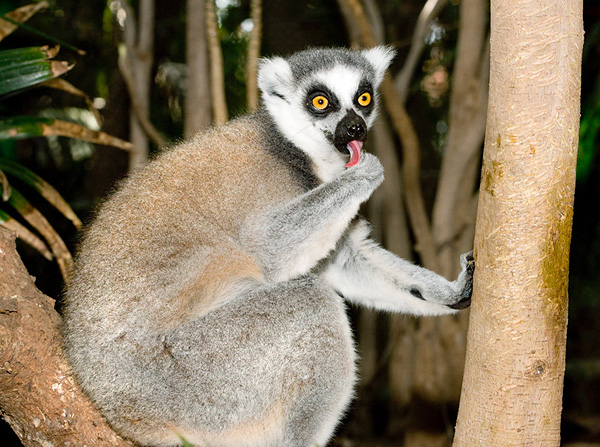
Indeed, they are harmless animals eating fruits, leaves and insects © Giuseppe Mazza
Finally, we must remind that Madagascar is the region of the Planet Earth counting the biggest number of species of Chameleons, family Chamaeleonids (Chamaeleonidae); but what makes the Malagasy fauna particularly original is the presence of prosimians, whose morphology is often far from that of a monkey in the common sense of the term, that is the lemurs.
Also the flora is endemic and quite original, much different from the continental one; due to the tripartite geographic nature in which Madagascar is subdivided, phytogeographical areas such as pluvial Forests (along the eastern coast), Savannahs (mainly in the western plains), deciduous Forests and plains (central highland) and thorny Forests followed by desert (south-western area) are evident.
Eight are the families of Angiosperms (Angiospermae) endemic to the island: they are the Didiereaceae, Kaliphoraceae, Sarcolaenaceae, Physenaceae, Didymelaceae, Asteropeiaceae, Sphaerosepalaceae and the Melanophyllaceae.
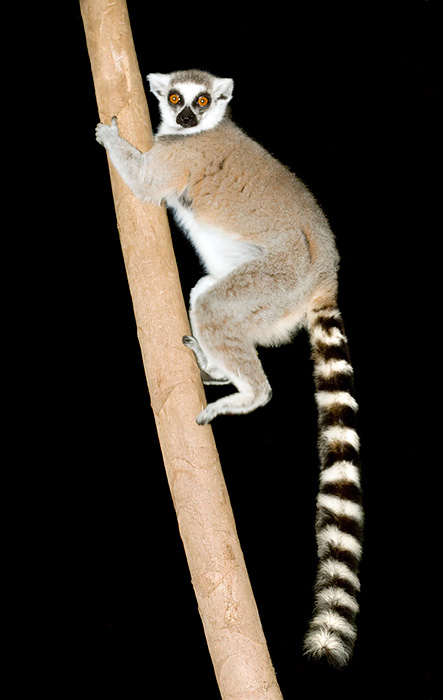
They are all endemic to Madagascar and arboreal © Giuseppe Mazza
Consequently, the term lemur becomes synonym of “phantom, ghost”, and it is easy to understand why the famous Swedish biologist Carl Linnaeus, father of the binomial nomenclature, did choose this name for designating these prosimians with nocturnal habits, who, with their hallucinated eyes and their appalling screams, did frighten the first explorers and biologist come to Madagascar as well as the tribal populations themselves. We can deduce that these prosimians represent the most original beings of the Malagasy fauna also from the fact that under the term “Lemuria” it is indicated a hypothetical lost continent, that, in prehistoric times, would have acted as physical bridge between the continental Africa and the Indian subcontinent, including also the Madagascar itself.
The lemurs are arboreal and mostly nocturnal animals, of the size of a cat and even of a mouse, nourishing of fruits, leaves or insects. Fossils confirm us that in previous times did exist, among the lemuriformes, some species of enormous size, such as the Megaladapis and the Paleopithecus, which did reach the size of a gorilla and which did disappear in prehistoric times. From the paleontological point of view, the lemurs have originated about 70 million of years ago, during the early Tertiary.
Nowadays species of lemurs were spread also in North America and in Western Europe and their findings might prove that the origin centre of these mammals is to be looked for in an Asian zone, from which they should have then spread in various directions.
Their settlement in Madagascar is very old and dates back to the Eocene, Tertiary or Cenozoic Era; the very long isolation, the absence of competition with other mammals, especially with the monkeys, the climate, extremely various in the different regions, all have allowed the adaptation of these prosimians to the different habitats of the island.
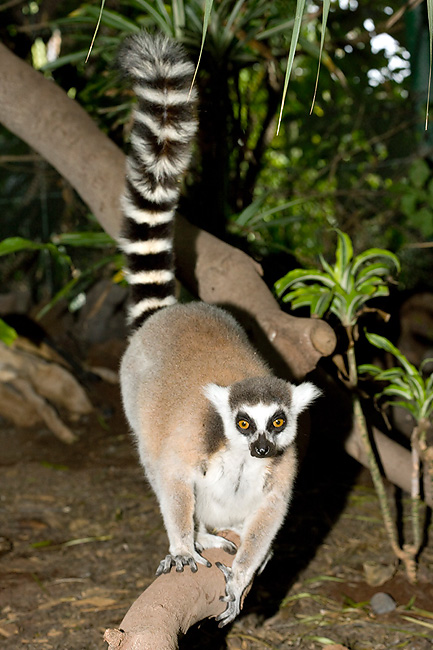
But Lemur catta often goes down to the soil © Giuseppe Mazza
Presently, the lemuriformes are represented by three families including 21 species, among which the spectral Aye-aye (Daubentonia madagascariensis), presently in danger of extinction, biologists advise that presently just some thirty specimens do exist. This worrying phenomenon, which previously was concerning only the lemuriformes, is now involving all other animal and vegetal forms endemic to the island. Amongst the extinct animals, the biologists relate about the gigantic bird Aepyornis, up to 3 metres tall and whose eggs reaching the weight of 10 kg, are known! Also the dwarf hippopotamus and the giant turtle were exterminated. It is nowadays no use to cry over the past caused by the human stupidity, it is better to react at once, because the threat weighing on the Malagasy fauna and flora is so alarming to make biologists think about a short term natural disaster.
Retracing quickly the history of this island, we can say that the destruction of its flora and fauna has begun 1500 years ago with the first settlements of the western man. The wonderful forests, which made to compare this region with a heaven on earth, were destroyed immediately in order to make room to farmlands.
But these last ones remained fertile only for a short time: the nature of the soil, which easily deteriorates in sterile clayey deposits, has transformed them in deserts which added to the natural ones of the island, mostly present in the arid southern regions. The fires and the cutting of trees, often belonging also to prized species, such as the ebony and the rosewood, utilized as fodder during the famine periods, have completed the destructive work.
So, in this way, an ecological balance lasted million of years has been disturbed, therefore especially the animal species connected with the forest, such, tightly, the lemurs, have suffered and with the time have decreased in the number of species as well as in that of individuals.
The French colonial government had created, from 1920 to 1940, with its biologists (zoologists and botanists), twelve National Parks and had placed under protection the flora and the fauna, among which several species of lemuriformes.
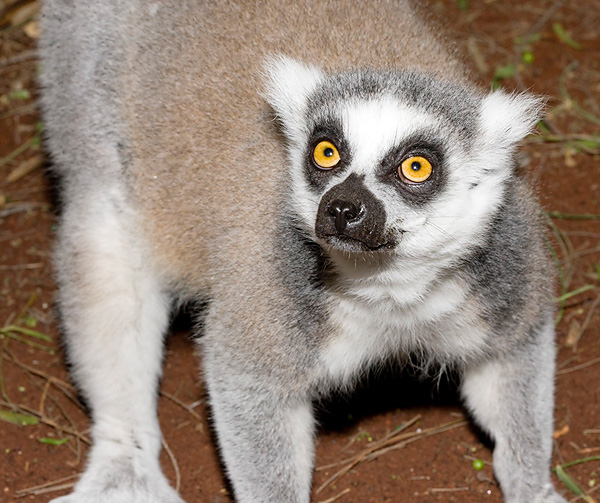
In fact it's a plantigrade even if thumb and big toe are opposable © Giuseppe Mazza
Officially protected are the White sifaka (Propithecus verreauxi), the Diademed sifaka (Propithecus diadema) and the Aye-Aye (Daubentonia madagascariensis), which live in the forests of the coastal belt around Madagascar and in some zones of the central highland.
In some instances, superstition is still protecting the lemurs. For instance, the Indri indri, called the “man with a dog’s head”, as, since the ancient times, this prosimian was called, is really singular.
This lemurid, discovered in 1870 by the French biologist Sonnerat, had the chance, since the prehistoric times, of enjoying the protection due to the supernatural powers the tribal populations had ascribed to it.
Indri indri , in the local dialect means “look look”; in fact, they narrate that two tribes were in war between them and the strongest one had launched in pursuit of the weakest, which had sought refuge in the woods.
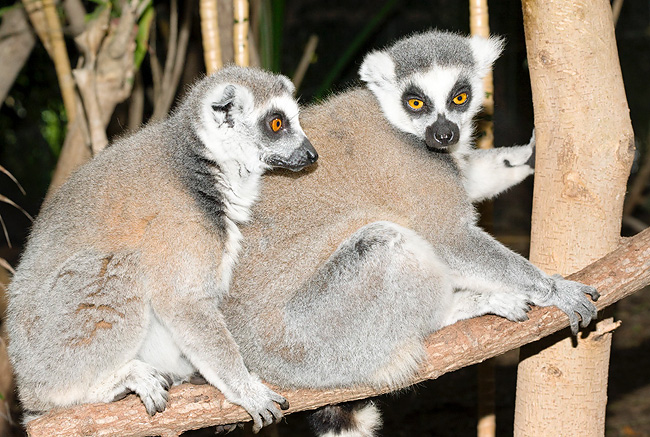
The brain is fairly developed but still "macrosmatic" with much evident olfactory lobes © Giuseppe Mazza
The population that saved itself thanks to this lucky situation, from that moment did never allow that these animals were killed.
Let us now describe the Ring-tailed lemur, or Katta.
The Ring-tailed lemur (Lemur catta), is a prosimian afferent to the class of the Mammals (Mammalia), to the order of Primates (Primates), to the suborder of the Lemuroids (Lemuroidea), to the family of the Lemurids (Lemuridae), to the subfamily of the Lemurines (Lemurinae), to the genus Lemur (Lemur).
The family of the lemurids is the riches in species among the three in which are subdivided the Lemuriformes (Lemuriformes) namely: the Lemuridae, the Indiridae and the Daubentonidae .
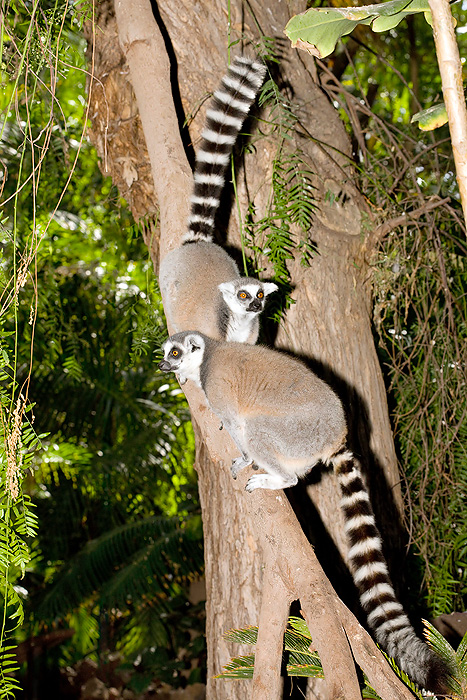
Unlike all other lemurs, Katta is mainly active by day © Giuseppe Mazza
The Lemuridae family includes a total of sixteen species that can be divided in two subfamilies, that of the Cheirogaleines (Cheirogaleinae) and that of the Lemurines (Lemurinae), based on differences of shape, size and habits of life. The cheirogaleines are smaller as they do not exceed the length of 30 cm; amongst them stand the smallest extant primates after the tree shrews.
The genus Lemur includes six species, two of which, the Lemur fulvus and the Lemur mongoz , populate, besides Madagascar, also the nearby Comoro Islands, nowadays Union of the Comoros, a small insular nation of south-eastern Africa, placed between Madagascar and Mozambique in the northern part of the Mozambique Channel. Among the lemurids, the Lemur catta is the most known species to the public because is frequently present in the zoological gardens and also as main actor in successful American cartoon films.
Zoogeography
It is a species endemic to Madagascar, mainly in the south-western areas; Ethiopian biogeographic region.
Ecology-Habitat
It differs from the other lemurids because carries on a mainly diurnal life and not only arboreal. As a matter of fact, it is often found also on the soil and between the rocks, in arid and without primary as well as secondary vegetation.
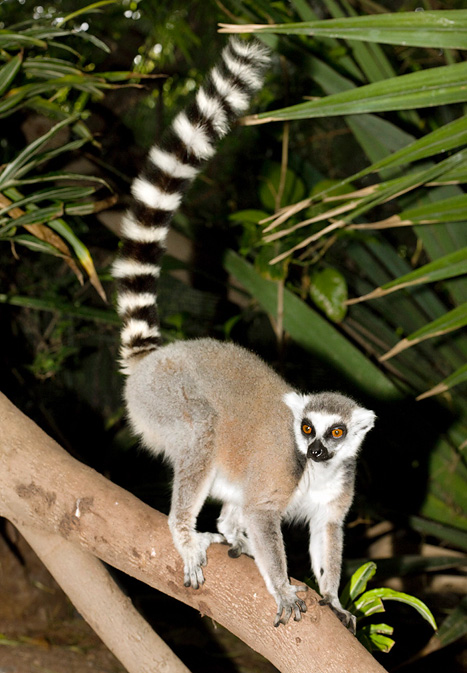
35-40 cm long plus a 50 cm tail, its livery is unmistakable © Giuseppe Mazza
Morpho-physiology
It has a length of 35-40 cm, to which we must add a 50 cm tail, which is, therefore, longer than the rest of the body. The most important anatomical characters of the Lemur catta , are the typical ones of the archaic primates. The brain is fairly developed if compared to more primitive forms, but is still of “macrosmatic” type, with much evident olfactory lobes. In the progressive evolution of the primates, it is getting more and more evident the reduction of the rhinencephalic portion (that part of the brain connected with the sense of smell), in favour of the increasing development of the neopallium areas (the neocortex); this phenomenon is just outlined in the genus Lemur.
The skull is leaning forward, with rather long nasal bones and four endo-turbinates (superior nasal airways). The ocular orbits are big and point forward. The maxillary and mandibular arches carry total of 36 teeth. There are nine of them per each hemi-arch, distributed as follows: two incisors, small and slightly spaced, a rather protruding and sharp canine, especially in the upper arch, three premolars and three molars. A quite interesting anatomical character for the biologists, on the phylogenetic point of view stands in the disposition of the tympanic ring and bulla.
Whilst in the insectivores, which are primitive mammals compared to the primates, the tympanic ring is free from the cranial bones, in the Lemur catta , like in all the Lemuridae , the ring is included into the tympanic bulla, sign this of a first evolutive step which, continuing in the lorisiformes with a situation which contemplates the merger between the ring and the tympanic bulla, will get progressively to the formation of a real “auditory meatus” in the Catarrhines (Catarrhini) monkeys.
In the katta, plantigrade, the limbs are pentadactylous, with the rear ones longer than the fore ones.
Furthermore, in the genus Lemur, like all Lemuridae, the thumb and the big toe are opposable to the other fingers as adaptation form to the arboreal life; however, in the Lemur catta, which loves moving a lot also on the ground, the sole of the foot is particularly long, with a reduced bug toe in order to allow a firm grip on the rocks.
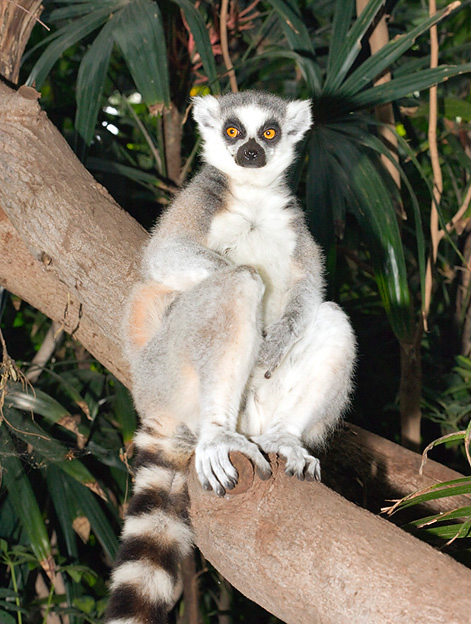
The Katta females deliver 1-2 babies once a year © Giuseppe Mazza
The region including the nostrils and the lips is black too, whilst the remainder of the muzzle and the belly are pale, almost white. Also the pinnae, well developed and turned upwards, are covered by a pale fur. The rest of the body and the legs are ash gray and on the back is evident a reddish shade.
The tail is formed by a succession of white and black rings, usually 14 per colour. The Lemur catta does not have a clear sexual dimorphism, transitory or seasonal, contrary to the Lemur macaco (Lemur macaco), the other much known species of the genus Lemur.
Ethology-Reproductive Biology
Essentially frugivorous, it does not disdain to eat also leaves and some insects or larvae.
This prosimian usually reproduces only once in a year and the pregnancy lasts from four to five months. The placenta is of a diffused and indeciduous type, which means that the chorial, or chorionic, villi develop over all the surface of the fecundated egg and adhere to the uterine mucosa (endometrium), leaving it intact.
At the parturition, usually one offspring comes to life, more rarely two, and this/these during the breeding time remain attached to the fur of the mother.
The IUCN establishes for this animal an NT status, Near Threatened to extinction. For the other ethological aspects, please refer to the taxonomical text about the Primates.
→ For general notions about Primates please click here.
→ To appreciate the biodiversity within the PRIMATES please click here.
